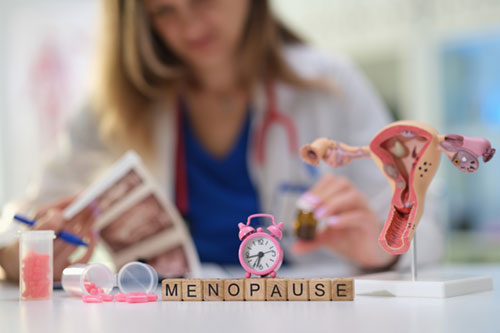
In modern medicine, much importance is given to quality of life. As Women’s Day approaches and we celebrate women and their achievements, we are also acutely aware of the medical requirements of the various phases in a woman’s life.
When these medical concerns are improperly met or ignored, productivity and longevity suffer. Menopause is one such phase in a woman’s life.
Menopause indicates the time when ovarian function ceases in a woman. It is also the time when women stop having their periods due to an acute decline in oestrogen and progesterone hormones.
To many, it marks a different phase in their lives, vastly different from the previous years. The changes are profound physically, mentally, emotionally and socially.
In this article, we discuss which symptoms in menopause need medical attention and the reasons for the same.
Post-Menopausal Bleeding (PMB)
This is an important symptom that should not be ignored. 10% of women with PMB will have endometrial cancer. Therefore, it is important to see a doctor and have a biopsy.
A hysteroscopy along with a biopsy is a gold standard in this situation and is a simple procedure that can be done as a day surgery.
Women with ovarian and cervical cancer also present with PMB. However, the most common cause of PMB is atrophic vaginitis which can be easily and effectively treated.
The incidence of cancers increases in the menopausal age group. Screening wherever offered in the form of mammograms, pap smears and stool examinations should be embraced.
With cancers, early detection is key to achieving a cure.
Vasomotor Symptoms
Hot flashes or flushes are described as a sudden feeling of warmth all over the body which can be quite disturbing. This can be associated with night sweats wherein the woman is drenched completely in sweat (more so at night). Both these symptoms indicate a dysregulation of the thermoregulatory system due to a lack of oestrogen.
Treatment varies from simple medication such as clonidine to hormone replacement treatment in the form of oral or transdermal oestrogens.
Urogenital Syndrome and Pelvic Floor Dysfunction
Vaginal discomfort, pain or burning occurs frequently in menopausal women due to a lack of oestrogen. This can cause bleeding per vaginum, pain during intercourse as well as dysuria or pain during micturition.
On examination, it is common to find a red and inflamed vaginal mucosa. Treatment in the form of vaginal oestrogen is extremely effective when used correctly.
Atrophic vaginitis as described above is also frequently associated with bladder symptoms such as increased frequency, nocturia, urgency and urge incontinence.
In menopause, it is also quite common to have signs of worsening pelvic floor dysfunction.
Many women struggle with incontinence of the bladder and sometimes of the bowel. It affects their quality of life significantly and stops them from doing the things they love, such as running, dancing or even being at a job for long hours. Sometimes, incontinence is a sign of infection, cancer and other serious diseases and therefore needs medical attention at presentation. Also, when patients present early, simple interventions such as supervised Kegel exercises help significantly.
Pelvic floor dysfunction primarily starts at the time of childbirth. When they are young, women compensate by the use of their accessory muscles. With menopause, these symptoms get worse.
Quite often, on examination, a uterovaginal prolapse is seen which presents as a bulge at the vaginal introitus. When the prolapse is left untreated, bladder and kidney infections, difficulty with passing stools and ulcers on the mouth of the uterus are frequently detected. Treatment of prolapse is primarily surgical with plenty of excellent and effective alternative options available.
General Health
The lack of oestrogen following menopause in women leads to the loss of its protective effect on the bones and heart. Women are therefore more prone to weak bones and ischemic heart disease at this stage.
It is imperative to have regular cardiac checks in this period and effectively address factors such as dyslipidaemia, hypertension and obesity that adversely affect cardiac health. A bone mineral density scan is normally offered to all women over the age of 50 years to detect bone strength. With menopause, bone health starts to decline. Women in this age group also tend to decrease physical activity. It is important to check your vitamin D levels regularly and make sure there is plenty of calcium in the diet in the form of dairy, eggs and nuts. Weight-bearing exercises are also very important and need to be included as part of the daily routine in addition to walking or running. When osteoporosis or osteopenia is detected, treatment in the form of calcium, vitamin D, and bisphosphonates are common.
Many women develop medical problems like diabetes and hypertension during this period. These illnesses, in the majority, present without much warning. Periodic health check-ups are therefore a must.
Obesity is a prevalent, poorly addressed condition that is the reason for a lot of other diseases like diabetes, dyslipidaemia, endometrial cancer, breast cancer, heart disease and poor bone health.
Women in this age group typically present with a lack of energy and this starts off a vicious cycle. Regular simple exercise at least 5 days a week in the form of walking for 40 minutes, yoga and meditation can be good starting points. The diet also needs to be addressed and necessary changes need to be made.
In conclusion, with proper attention, regular check-ups and input from your doctors, menopause can be a productive and peaceful phase.
The key is being body and mind aware and not discounting or ignoring small symptoms.

Dr Vaishnavi V L. MD MRCOG DFSRH CCT
Senior Consultant OBGYN and Urogynaecology,
Kauvery Hospital, Chennai

